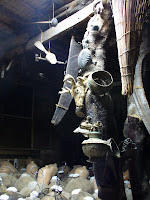
As far back as anyone can remember, there's been a hair place (peluquería) on the corner of San Felipe's commercial center, next to the launderer's, which has also been there as long as anyone can recall.
While today it is a beauty parlor and hairstyling shop - in the old days it was a true barbershop, with a full complement of barbers and swivel chairs with straps hanging from them to sharpen the razors.
In the latter 1980s it started to shift its attention more toward women's hair, but it still drew a loyal male clientele. Some years later, the then-owner had a dispute with the main stylist, Sandro, who consequently left to open his own peluquería a hundred or so yards away, in Los Cedros. Sandro drew away many clients, and there are still many people who won't let anyone else cut or style their hair.
While today it is a beauty parlor and hairstyling shop - in the old days it was a true barbershop, with a full complement of barbers and swivel chairs with straps hanging from them to sharpen the razors.
In the latter 1980s it started to shift its attention more toward women's hair, but it still drew a loyal male clientele. Some years later, the then-owner had a dispute with the main stylist, Sandro, who consequently left to open his own peluquería a hundred or so yards away, in Los Cedros. Sandro drew away many clients, and there are still many people who won't let anyone else cut or style their hair.
One thing that has remained constant, however, is the horse.
Anyone from San Felipe who sees this would instantly recognize where it came from, and any number of us can recall sitting at one of these while getting our hair cut with the invariably huge-seeming scissors, which SNIPPED loudly and menacingly in one's ears.
For us boys, at least, the thrill of the horse "ride" was dampened afterward by the results on our hair. Even in those 1970s days of long hair and bangs, there were but two styles of haircut at that shop, it has been said: the military and the schoolboy, and the relationship between the two was close and clear.
For us boys, at least, the thrill of the horse "ride" was dampened afterward by the results on our hair. Even in those 1970s days of long hair and bangs, there were but two styles of haircut at that shop, it has been said: the military and the schoolboy, and the relationship between the two was close and clear.
Originally there were four of these cast metal horses around a mirrored pillar. Today there is just the one, sitting in a corner of the shop, a forlorn bearer of innumerable memories waiting for new riders.































